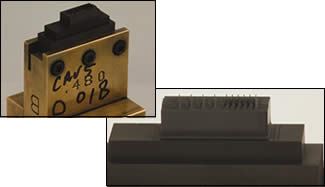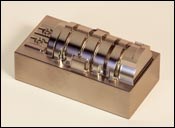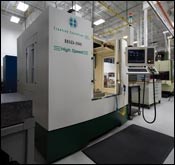A Machine Cuts Carbon and Hard Steel at 60 Percent of the Cost
The right high-speed machining center and software helps one mold builder turn an important corner in mold building productivity.
Share
Read Next
Are you struggling with the decision to buy a new graphite mill or a new hard mill? Hard milling can cut about 75 percent out of the time and cost to make inserts in some cases, yet hard milling can’t do it all. The perfect scenario would be a machine that could do both very well.
The capacity to mill graphite electrodes or hardened steel inserts on the same machine can give you a lot of flexibility. The machine must do both well—without lengthy cleanup or changeover time—to be practical.
ADC (Minneapolis, MN) is a world-class manufacturer of communications connectivity for building site wiring with copper and fiber optics technology. Moldmaker Bryan Karst says, “We needed a new graphite mill because we struggled to hold .0015" between electrodes on our existing mills. This doubled the workload for the EDM operators to check and adjust each ‘trode individually at setup for burning.”
American mold builders are all challenged by global competition and ADC is no exception. In spite of the fact that the mold building department is captive to the corporation, they still need to compete with the rest of the industry for ADC’s mold manufacturing business. “Our customer, our own engineering department, was pushing for lower cost and faster turnaround,” Karst says.
Supplier Solution
“After checking out several popular and high-end graphite mills, a local machinery dealer, All Tech Machinery and Supply, introduced us to Creative Evolution,” Karst recalls. “The salesman said they could cut our test part with a machine that could cut both carbon and hard steel.
“We submitted an electronic model and toolpaths for our test part to Creative,” he continues. “We had experimented with hard milling this part earlier on our own equipment. Working with CAM-TOOL from Graphic Products North America for programming, Creative Evolution was able to show us great results within just a couple weeks. Initially they provided video clips of the test cuts. When we traveled to see the milling firsthand, we saw that the Creative Evolution runs smoother than the other machines we had seen, resulting in a terrific looking part. By hard milling the insert (see Photo 1), the Creative Evolution HSD-500 and CAM-TOOL cut out about 50 percent of the time it took us to make the same insert.
“A couple of us attended MoldMaking Expo 2007,” Karst adds. “This was a great opportunity for us to collect more information in a short time. It was a small show when compared with the likes of IMTS or other trade shows, yet we learned a lot. The entire show was very focused on our specific needs for moldmaking, so we didn’t have to waste a lot of time sorting out what applied for us. We attended some excellent seminars. We confirmed Creative Evolution’s claims that when applicable, hard milling could deliver a better product in a lot less time than our EDM process. We needed a new electrode mill, and wanted hard milling too. Unfortunately, we were already stretching our budget.”
Machine Considerations
“We use a team process for selection of equipment. Like every company, we need to get the most bang for our buck,” explains Jeff Kes, team leader for this selection. “Suggesting the model HSD-500 high-speed machining center, Creative Evolution offered us a package that fit our needs and budget, about 60 percent the cost of the other machines with matching capabilities. We called Creative Evolution customers and visited a number of them to check out the machines. We were impressed with the testimonials each of them provided us.
“The spindle was a key factor in our evaluation,” Kes continues. “Throughout our machine selection process, we were faced with replacing our best machine’s spindle. The $20,000 price tag to repair our 20,000-rpm spindle made us wary. As we researched competitive machines, we found that high-speed spindle repairs could cost $30,000 or more, depending upon the machine. We learned that Creative Evolution stocks advance exchange spindles and charges based on the repair charge for the spindle taken from your machine, normally about $4,500.00, a fraction of the others.”
The Creative Evolution HSD-500 (see Photo 2) is a HSM center with 20" x 16" x 16" travels, 16-station toolchanger and a 30,000-rpm spindle. Standard graphite protection on all machines includes an enclosed toolchanger, sealed way covers and additional telescoping covers for the ballscrews. Pressurized oil lubrication of the Schneeberger roller guideways and precision ballscrews constantly flushes contaminants and refreshes the lubricant.
The dust collection system is a key component of the machine system. Creative Evolution’s Torit dust collector does a great job of sucking up the carbon, and that’s pivotal to the machine’s success milling both graphite electrodes and hard steel.
“A clean machine and work environment is healthier and a lot more enjoyable,” Karst notes. “It’s easier to think and work to .0001" tolerances when your workspace is neat and clean. This unit is really quiet, too. We take a lot of pride in what we do here,” he emphasizes, gesturing around the spacious, impressive facility.
The Creative Evolution CNC control has been known for high-performance milling since its introduction in 1993. Creative Evolution introduced complete machines in 2001. “Our machines’ successful performance over many years has proven the control and the machine’s ability to change the competitive climate for our clientele. By keeping their performance up and their investment down, we reduce our customers’ hourly cost, leaving more money in his pocket for further investment in his future or as a profit,” says Creative Evolution VP Todd Schuett.
Creative Evolution claims their pricing advantage and ability to service so well stems from a conscious effort to prevent service visits. “From its inception, the Creative Evolution CNC was planned to reduce maintenance by using commonly available PC technology as much as possible,” Schuett states. “Thorough documentation of the control’s features and service also helps by empowering customers to help themselves.
“Another important feature is the control’s ability to be updated with new features,” Schuett continues. “Our first controls from 1993 can run today’s software and can be fully updated to the Creative Evolution CNC’s latest features for a reasonable price. The latest technology is always an advantage, but when it costs too much, it can limit a company’s balance of investment or even jeopardize a company’s financial health. In this rapidly changing world, our clients can keep up with the latest technology for a much lower investment with less risk. This gives them a distinct competitive advantage.”
Making the Purchase and Reaping the Rewards
The team decided on the Creative Evolution HSD-500 and the purchase was made. Installation of ADC’s new HSD-500 was carried out over just a few days, including a test cut in hard steel to demonstrate performance. “Within a week of installation, we had achieved our need for a faster and more accurate graphite mill, and we proved out our new capability to cut hard steel inserts,” Karst says.
Installation included setup, on-site laser calibration of the machine and on-site training. ADC’s own test part was used for training, providing an ideal learning base for the latest techniques used in both graphite and hard milling.
The results affirm the team’s decision. Karst reports that ADC now cuts accurate electrodes in 60 to 70 percent less time and they need less hand work. They now mill electrodes for tiny details, like ribs as thin as 0.002" (see Photos 3a,b).
Hard milling is the method of choice about a quarter of the time now. “In the past, cutters 1/16" and under were nearly impossible to use because their performance and life was so unpredictable,” Karst explains. “Now we are routinely using cutters from .250 diameter down to .015 diameter and sometimes as small as .008 diameter. The spindle speeds, feedrates and stepover increments are pretty similar between graphite and hard milling. With EDM we would cut three electrodes and then burn the insert. The end result is about a 75 percent reduction in our time to make the same inserts by hard milling.”
Another benefit of the hard milling is in the polishing. Karst says that while there is no apparent difference in the time, the polishers say it is easier to polish the machined surface than it is to polish the recast layer from EDM.
The flexibility to cut graphite and hard steel can be a key for success. Hard milling isn’t for everyone or for every job. It needs to be recognized as just another tool in your box. Sharp inside corners, steel hardness and the length to diameter ratio of the cutter are major challenges. In many cases it may be possible to cut a cavity or core by hard milling, yet that may not be the most profitable method to build the mold. The key is having the choice.
“Corner radii are critical in our decision whether or not to hard mill,” Karst emphasizes. “Our engineering department’s drive for faster delivery and lower cost has made them very agreeable when we ask for design flexibility. Working together we’re making the end parts look better and it is easier to hard mill the tools by adding radii in many corners where practical.” This cooperation between vendor and customer can be a critical advantage for everyone’s success in today’s marketplace.
The hardness of the material and the cutters needed are also deciding factors whether to hard mill or use EDM reports Karst. Many of the molds manufactured today at ADC are made with Stavax®11, a special grade of 420 stainless steel used in molds for its corrosion resistance.
Typically heat treated to 50 HRc or harder, this is tough material to cut. ADC has found that for small cutters, a length to diameter (L:D) ratio of 10:1 is about the practical limit. Longer than 10:1 is possible, but with the slower spindle speeds and feedrates required as L:D ratios grow, the time and the tooling cost goes up.
Shortly after implementing the new high-speed mill, ADC installed its first seat of CAM-TOOL software for making cutter paths. “CAM-TOOL has made a huge contribution to our success with hard milling,” Karst boasts. “We get more efficient and reliable cutter paths with less effort than was previously possible. The parts look better too, reportedly because CAM-TOOL works to true part surfaces. Another bonus CAM-TOOL provides is an electrode extraction feature that saves a huge amount of time on the jobs that require EDM operations.”
Higher Productivity Gains
A year ago, hard milling and higher productivity seemed like a long-term goal. Networking with vendors and sales people, and attending MoldMaking Expo 2007 helped ADC find a solution. The Creative Evolution HSD-500 and CAM-TOOL software helped ADC turn an important corner in mold building productivity.
“Our mold building department competes on a global basis today. The choice to use the best process is pivotal to our success,” says Dave Brown, Operations Leader for Tool & Die. “China isn’t meeting our customers’ need for delivery or quality. Eight- to 12-week deliveries a year or two ago have been trimmed to four to five weeks today. Our quality is better than ever, in spite of the tight deliveries. Using the latest technology, we are once again our customer’s preferred vendor.”
References
1 Stavax is a registered trademark of Böhler Uddeholm.
Related Content
6 Ways to Optimize High-Feed Milling
High-feed milling can significantly outweigh potential reliability challenges. Consider these six strategies in order to make high-feed milling successful for your business.
Read MoreTreatment and Disposal of Used Metalworking Fluids
With greater emphasis on fluid longevity and fluid recycling, it is important to remember that water-based metalworking fluids are “consumable” and have a finite life.
Read MoreMoldmakers Deserve a Total Production Solution
Stability, spindle speed and software are essential consideration for your moldmaking machine tool.
Read MoreAdvantages and Disadvantages of Copper and Graphite Electrodes
Both copper and graphite provide approximately the same end result, so it is important for a shop to consider the advantages and disadvantages of each material in order to discover what would work best in their shop floor environment.
Read MoreRead Next
Are You a Moldmaker Considering 3D Printing? Consider the 3D Printing Workshop at NPE2024
Presentations will cover 3D printing for mold tooling, material innovation, product development, bridge production and full-scale, high-volume additive manufacturing.
Read MoreHow to Use Strategic Planning Tools, Data to Manage the Human Side of Business
Q&A with Marion Wells, MMT EAB member and founder of Human Asset Management.
Read MoreHow to Use Continuing Education to Remain Competitive in Moldmaking
Continued training helps moldmakers make tooling decisions and properly use the latest cutting tool to efficiently machine high-quality molds.
Read More













.jpg;maxWidth=300;quality=90)













